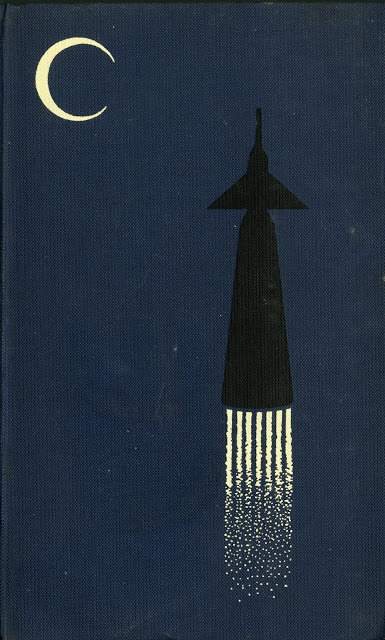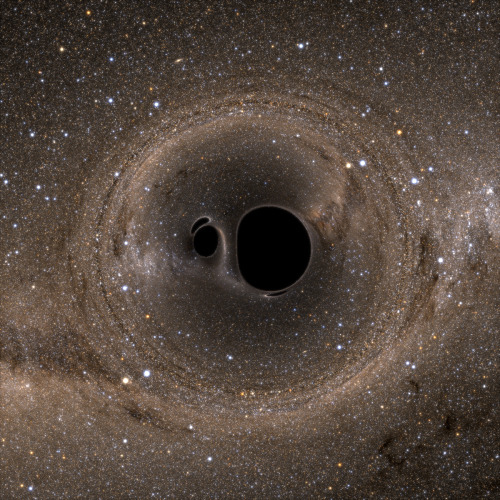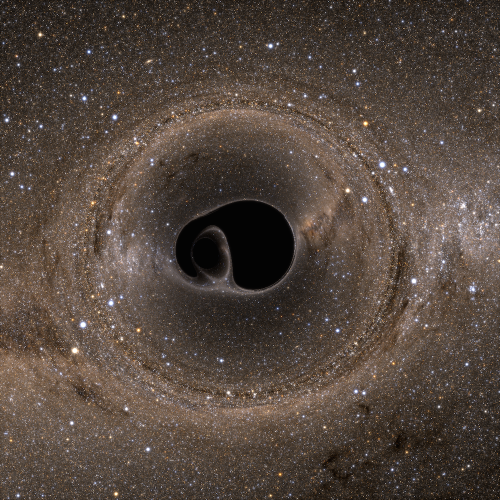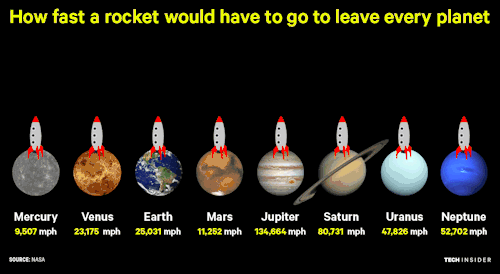First Men To The Moon (1960); Cover

First Men to the Moon (1960); cover
More Posts from Paratus-simulator and Others


A Black Hole is an extraordinarily massive, improbably dense knot of spacetime that makes a living swallowing or slinging away any morsel of energy that strays too close to its dark, twisted core. Anyone fortunate (or unfortunate) enough to directly observe one of these beasts in the wild would immediately notice the way its colossal gravitational field warps all of the light from the stars and galaxies behind it, a phenomenon known as gravitational lensing.
Thanks to the power of supercomputers, a curious observer no longer has to venture into outer space to see such a sight. A team of astronomers has released their first simulated images of the lensing effects of not just one, but two black holes, trapped in orbit by each other’s gravity and ultimately doomed to merge as one.
http://www.universetoday.com/116500/new-simulation-offers-stunning-images-of-black-hole-merger/?
Our universe seems to be getting bigger and bigger.
10 Times More Galaxies!
The universe suddenly looks a lot more crowded…
We already estimated that there were about 100 billion galaxies in the observable universe, but new research shows that this estimate is at least 10 times too low!

First, what is the observable universe? Well, it is the most distant part of the universe we can see from Earth because, in theory, the light from these objects have had time to reach Earth.

In a new study using surveys taken by the Hubble Space Telescope and other observatories, astronomers came to the surprising conclusion that there are at least 10 times more galaxies in the observable universe than previously thought. This places the universe’s estimated population at, minimally, 2 trillion galaxies!

The results have clear implications for galaxy formation, and also helps shed light on an ancient astronomical paradox – why is the sky dark at night?
Most of these newly discovered galaxies were relatively small and faint, with masses similar to those of the satellite galaxies surrounding the Milky Way.

Using deep-space images from the Hubble Space Telescope and other observatories, astronomers converted the images into 3-D, in order to make accurate measurements of the number of galaxies at different epochs in the universe’s history.
In addition, they used new mathematical models, which allowed them to infer the existence of galaxies that the current generation of telescopes cannot observe. This led to the surprising conclusion that in order for the numbers of galaxies we now see and their masses to add up, there must be a further 90% of galaxies in the observable universe that are too faint and too far away to be seen with present-day telescopes.

The myriad small faint galaxies from the early universe merged over time into the larger galaxies we can now observe.
That means that over 90% of the galaxies in the universe have yet to be studied! In the near future, the James Webb Space Telescope will be able to study these ultra-faint galaxies and give us more information about their existence.

So back to the question…Why is the sky dark at night if the universe contains an infinity of stars? Researchers came to the conclusion that indeed there actually is such an abundance of galaxies that, in principle, every patch in the sky contains part of a galaxy.
However, starlight from the galaxies is invisible to the human eye and most modern telescopes due to other known factors that reduce visible and ultraviolet light in the universe. Those factors are the reddening of light due to the expansion of space, the universe’s dynamic nature, and the absorption of light by intergalactic dust and gas. All combined, this keeps the night sky dark to our vision.
Make sure to follow us on Tumblr for your regular dose of space: http://nasa.tumblr.com








NASA originally commissioned these posters for an exhibit at the Kennedy Space Center Visitor’s Complex in 2009. As part of their Journey to Mars, these versions are now available to everyone online.
Credit: NASA/KSC

Marvin created a displacement map from the moon landscape by the U.S. Geological Survey (USGS). He's still working on this, but it looks like it's coming along!
-
 chaoticmusiccollectors reblogged this · 1 month ago
chaoticmusiccollectors reblogged this · 1 month ago -
 eclectichellmouth reblogged this · 2 years ago
eclectichellmouth reblogged this · 2 years ago -
 mythshotelsrestaurants reblogged this · 3 years ago
mythshotelsrestaurants reblogged this · 3 years ago -
 mythshotelsrestaurants liked this · 3 years ago
mythshotelsrestaurants liked this · 3 years ago -
 thatawkwardstage reblogged this · 4 years ago
thatawkwardstage reblogged this · 4 years ago -
 andre-sobrinho-blog liked this · 4 years ago
andre-sobrinho-blog liked this · 4 years ago -
 lascopadelsistema liked this · 5 years ago
lascopadelsistema liked this · 5 years ago -
 mypersonalwallofshame reblogged this · 5 years ago
mypersonalwallofshame reblogged this · 5 years ago -
 mypersonalwallofshame liked this · 5 years ago
mypersonalwallofshame liked this · 5 years ago -
 5lj162yq reblogged this · 5 years ago
5lj162yq reblogged this · 5 years ago -
 seiorand liked this · 6 years ago
seiorand liked this · 6 years ago -
 stubbornbliss reblogged this · 6 years ago
stubbornbliss reblogged this · 6 years ago -
 theseeker1864 liked this · 6 years ago
theseeker1864 liked this · 6 years ago -
 girlscientist liked this · 6 years ago
girlscientist liked this · 6 years ago -
 jtnebr0908-blog liked this · 6 years ago
jtnebr0908-blog liked this · 6 years ago -
 sihayanami reblogged this · 6 years ago
sihayanami reblogged this · 6 years ago -
 urbantaroist liked this · 6 years ago
urbantaroist liked this · 6 years ago -
 baronafanas002 liked this · 6 years ago
baronafanas002 liked this · 6 years ago -
 lepiratepsychique liked this · 6 years ago
lepiratepsychique liked this · 6 years ago -
 soundwavesopretty liked this · 6 years ago
soundwavesopretty liked this · 6 years ago -
 smugglers-soul reblogged this · 6 years ago
smugglers-soul reblogged this · 6 years ago -
 yoursticazzi liked this · 6 years ago
yoursticazzi liked this · 6 years ago -
 genderfluidandrogynous liked this · 6 years ago
genderfluidandrogynous liked this · 6 years ago -
 kmdn12-blog liked this · 6 years ago
kmdn12-blog liked this · 6 years ago -
 harlotscarlet-singinginthegarden reblogged this · 6 years ago
harlotscarlet-singinginthegarden reblogged this · 6 years ago -
 ridinghood57 liked this · 6 years ago
ridinghood57 liked this · 6 years ago -
 soyjericoone reblogged this · 6 years ago
soyjericoone reblogged this · 6 years ago -
 adauntlessjourney liked this · 6 years ago
adauntlessjourney liked this · 6 years ago -
 cantweall-justgetabong reblogged this · 6 years ago
cantweall-justgetabong reblogged this · 6 years ago -
 stubbornbliss liked this · 6 years ago
stubbornbliss liked this · 6 years ago -
 a-s-h reblogged this · 6 years ago
a-s-h reblogged this · 6 years ago














